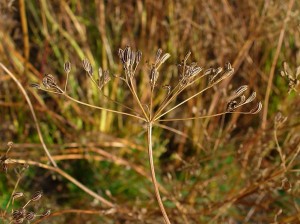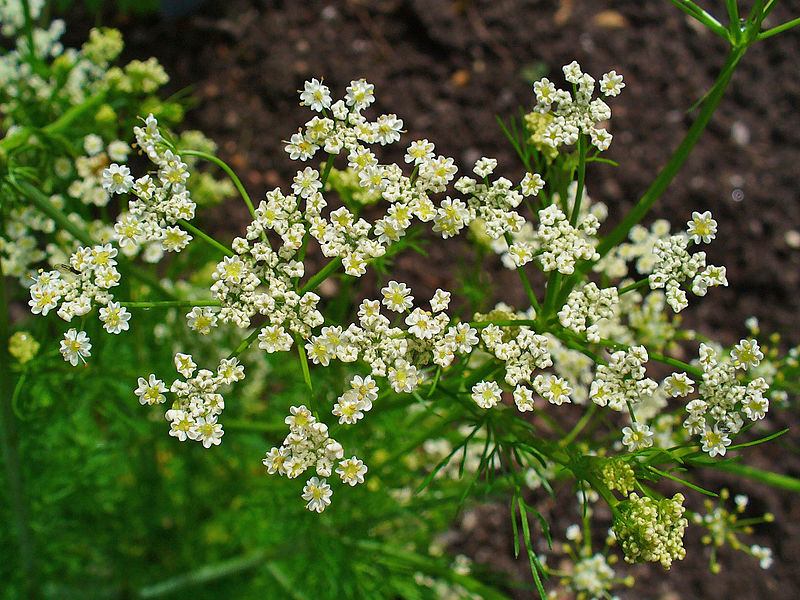Do you love the idea of growing spices but are faced with the reality of 3-month growing season? We can all admit that cardamom, cinnamon, vanilla, saffron, ginger, and nutmeg all echo with the mystique of an exotic locale. No matter, there are spices you can grown in your backyard, even if your growing zone is better known for maple syrup, pine trees, or snow-covered mountains.
Now when I say spices, I’m not talking herbs (if you want clarification read herbs vs. spices.) I am talking common sense. Build a state-of-the-art greenhouse and you can grow whatever, whenever, and wherever you want. Not exactly realistic for most of us.
This is about your backyard…or front. Easy to do, pretty to look at, and rewarding to harvest are the operatives actions here. It’s spring so it’s time to sow some seeds. Caraway, to be specific.
First, a story. About 14 years ago my then fiance and I lived in the middle of a field, on a hill with a cow pasture and a barn in Upstate New York. We rented the house, which was built around 1810. One August afternoon I went down to say hello to the herd (all 7 of them) and noticed a plant that looked strikingly similar to Queen Anne’s Lace. It was tall with delicate leaves, brown seeds and a familiar fragrance. The farmer explained it was caraway, originally planted in the late 1800’s by his great-great something-or-other relative. He showed me how to take the flowers and shake them upside down for the seeds. I carefully put the little handful of treasure in a bottle. That night I toasted the seeds and sprinkled them on green beans with some butter.
Wow!
Can I just tell you how cool it is to season a fresh, simple vegetable with a homegrown spice? I happen to like caraway seeds. Totally irrelevant. The novelty of having my own spice right outside the kitchen door was so fun I would have happily eaten them no matter the flavor.
How To Grow Caraway
What You Need:
A patch of well-drained sandy soil, that receives full sun in a growing zone 3-9. You can access an online version of the U.S. growing zones. Just click on your state to see more details on your zone.
You’ll also need caraway seeds for planting. Here are two sources and two price points.
One from Seed Needs, a family-owned seed company that does business through Amazon.
The other from Country Creek Acres an online seed store specializing in organic, non GMO seeds.
What You Do:
Caraway plants do best when started with seeds. Sow directly into a well-drained soil and lightly cover with a thin layer of soil in the spring or fall. You can prep the soil by scratching some compost into the top 1-2 inches. Remember, I found our happy patch on a well-drained, full sun slope next to a cow pasture. Paradise to a caraway plant.
What to Expect:
Caraway is a biannual. This means it takes two years for the plant to mature, produce seeds, then die. During the winter you may not see any evidence of the plant even though the roots are preparing for spring. So mark your spot carefully so you don’t accidentally dig them up in the spring.
Caraway will grow about 8 inches the first year and up to 2 ft. in the second. Harvest the seeds when they have ripened but before they fall to the ground. Cut the flower heads and gently shake over a shallow pan to catch the seeds. Put your seeds in a jar and try gently dry roasting them before using to enhance their flavor.
Some Tips:
Caraway is a plant with delicate lacy leaves and flowers. It doesn’t like to be transplanted. The leaves and roots are also edible. I haven’t ever tried them but I’ve heard the leaves taste like dill (I wonder if dill seeds taste like caraway?)
Pair Caraway with:
Caraway seeds have a sharp, pungent, slightly licorice taste that’s is delicious with green beans, potatoes, cabbage, onions, brussel sprouts, tomatoes, and apples. Try mixing it with cucumber and sour cream. It’s delicious with sausage and beef.
For more on caraway including exciting pairings, history and recipes check out the Twitter SpiceChat caraway recap from @TableFare. SpiceChat is the first Wednesday of each month. All you need is a Twitter account and the hashtag #spicechat (allows you to search and track contributions to the chat—just type #spicechat into the search box and boing, you’re there).
What spices have you grown or attempted to grow in your backyard, rooftop, flowerbox, porch or community garden?





May 11, 2011 at 10:59 pm
YES!! I’ve done this – quite by mistake but very successful. And fun. Thanks for the reminder.
May 12, 2011 at 6:16 am
What a lovely story – sounds like the start of Jack and the Beanstalk! You know, I’m now into herbs in the garden but now you’re inspiration on spices has got me thinking. What a wonderful idea! Thanks for all the advice and explanations. Super post.
May 12, 2011 at 7:41 am
@Pam I think if you find a plant that you love that volunteered its services your garden is trying to tell you something—you need more of said plant! 🙂 Fun though, isn’t it?
@Jill If I remember correctly you live in Paris which I believe has a climate that would fit within the U.S. Grow zone 3-9. Paris is mighty cold in the winter…I’m willing to bet caraway would do just fine there. BTW– for anyone else, Jill wrote a wonderful post about harvesting stinging nettle so check it out. Caraway is a little easier to harvest!
May 12, 2011 at 12:30 pm
great post and advice! I have never grown caraway, but I use it alot — perhaps this is the year to plant a new spice! Theresa
May 12, 2011 at 5:34 pm
Thank you for such great post!I am trying to grow some herbs now and definitely would like to grow caraway seeds as well.
May 22, 2011 at 4:13 pm
Yes!!!! I finally found a website that claimed to teach the growing of spices that wasn’t about growing herbs instead. I was beginning to think it was all a delusion that herbs and spices are not the same thing.
It’s good to know that I am not insane.
May 22, 2011 at 8:02 pm
@ Steve — LOL. Yes, there is a difference althought depending on how you interpret the definition there is a gray area. I did a post specifically on herbs vs. spices. It was fun to explore. And technically, caraway is a seed. There’s that gray area again…but everyone here, including me, seems fine with our kitchen vernacular and calling caraway seeds…a spice. Thanks for chiming in!
May 23, 2011 at 6:19 pm
This is one I have yet to grow but I do so love these beautiful seeds 🙂
May 25, 2011 at 9:40 am
Aren’t they lovely? They are gorgeous in the autumn and and look pretty poking up through a first snow.
August 8, 2012 at 1:45 pm
Wow! Okay, this is my next herb to grow! Do you know if you can get much within the first year? I’m only going to be in this house for one more summer as we’re moving in the Autumn of 2013.
March 4, 2013 at 10:38 am
Hi Tamara,
Quite honestly I’m not sure how much you get the first year. They do need at least two years to get fully established. I was using a patch that was started years ago. They grew so happily, and the conditions are common in the Northeast, which is why I wanted to share. Good luck…hope you planted in autumn and now are looking for the shoots this spring of 2013!